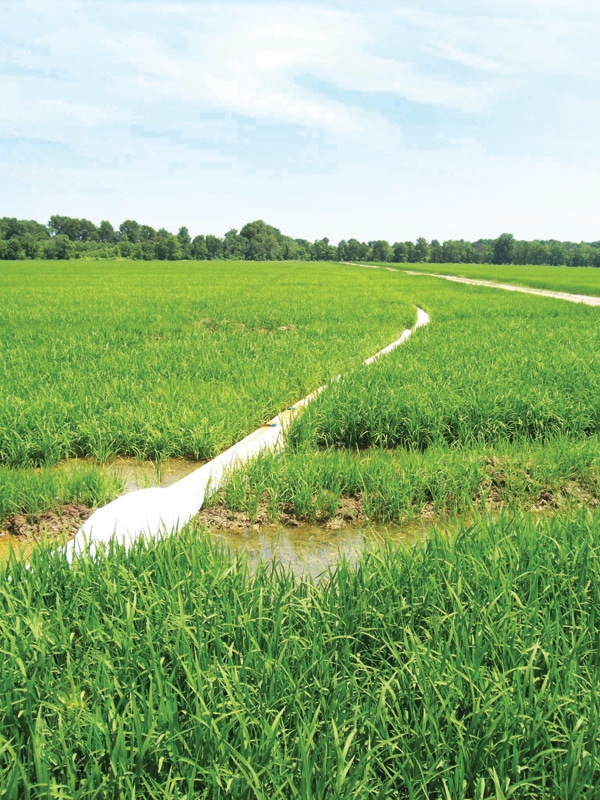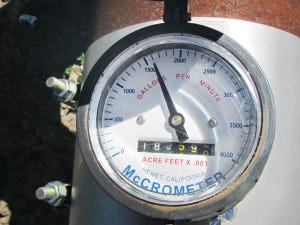
Irrigation Water Management (IWM) programs available through the USDA's Natural Resources Conservation Service can help growers to determine and control the volume, frequency, and application rate of irrigation water in a planned, efficient manner. This is top-of-field management that helps with control of inputs and limits tailwater losses.

As irrigation continues to expand and pumping costs increase, producers can utilize a number of tools and services through the USDA’s Natural Resources Conservation Service to help them more efficiently water their crops.
Some offer cost-share assistance, says Paul Rodrigue, supervisory engineer for USDA/NRCS Area 4 at Grenada, Miss.
“Our Irrigation Water Management (IWM) programs can help growers to determine and control the volume, frequency, and application rate of irrigation water in a planned, efficient manner,” he says. “This is top-of-field management that helps with control of inputs and limits tailwater losses,” he says.
IWM can be used as part of a conservation management system to support one or more of the following:
· Manage soil moisture to promote desired crop response/yield quality.
· Optimize use of available water supplies/water conservation.
· Minimize irrigation-induced soil erosion.
· Decrease non-point source pollution of surface and groundwater resources, reducing/eliminating tailwater.
· Reduced energy consumption.
“This practice is applicable to all irrigated land,” Rodrigue says. “An irrigation system adapted for site conditions — soil, slope, crop being grown, climate, water quantity/quality, etc. — must be available and capable of applying water to meet the intended purpose.”
IWM, he says, increases the management of irrigation systems and methods, typically by combining several individual elements into a comprehensive strategy.
Some of the typical management strategies used in the Mississippi Delta include:
· For all irrigation types: Water measurement (flow rates/volumes), timers/pump automation, irrigation scheduling methods, soil moisture monitoring (for flood irrigation, this may be visual observation of the flood).
· Furrow irrigation: Polypipe hole sizing method (Phaucet or equivalent), surge/cutback irrigation, furrow diking.
· Flood irrigation: Zero grade, multiple side inlets, rice markers.
· Center pivot: Drop nozzles, re-nozzling (example, low pressure, reduced application intensity).
· Aquaculture: Split pond method, 6/3 water management.
A number of items should be considered when planning irrigation water management, Rodrigue says.
“Consideration should be given to managing precipitation effectiveness, crop residues, and reducing system losses. Also, modification of plant populations, crop and variety selection, and irrigated acres to match available or anticipated water supplies.”
And he says, producers should avoid traffic on wet soils in order to minimize soil compaction, and consider improving the irrigation system to increase distribution uniformity of irrigation water application (example, polypipe hole sizing).
“At a minimum, each water source should be evaluated yearly for pump output/water measurement,” he says. “This should be done at each outlet point/riser. This measurement can be used to evaluate how much/how long to irrigate.
Terminating water application
“A timer or other pump control should be installed to terminate water at the time decided upon. A basic irrigation scheduling method (example, checkbook method) should be applied to determine when irrigation is needed.”

A TIMER or other pump control should be installed to terminate water at the time decided upon.
In addition to the basic IWM system, an intermediate system may also add management strategies that can assist in providing water to the field in a more timely and effective manner, Rodrigue says.
“These could include polypipe hole sizing methods to create better irrigation distribution uniformity, multiple side inlets in flood irrigation to get water to individual components, surge/cutback methods to reduce tailwater, and furrow diking to increase irrigation application efficiency and maximize the benefit of rainfall during the growing season.”
An advanced IWM system, he says, could include soil moisture monitoring and advanced irrigation scheduling methods. “Soil moisture measurement can be used to assist in determining irrigation scheduling and the effectiveness of each irrigation.”
The following principles should be applied for various crop growth stages, Rodrigue says.
· The volume of water needed for each irrigation should be based on plant available water-holding capacity of the soil for the crop rooting depth (see websoilsurvey.nrcs.usda.gov/app/WebSoilSurvey.aspx), management-allowed soil water depletion, and irrigation efficiency.
· The irrigation frequency should be based on the volume of irrigation water needed and/or available, the rate of crop evapotranspiration, and effective precipitation (this is extremely difficult to evaluate without soil moisture monitoring).
· The application rate should be based on the volume of water to be applied, the frequency of irrigation applications, soil infiltration and permeability characteristics, and the capacity of the irrigation system.
Water management critical

FLOW METERS are among the devices that can help producers to more effectively manage irrigation water use.
“Water measurement is the first and most crucial step in any IWM plan,” Rodrigue says. “Knowing how much water a pump is supplying is critical to decision-making in irrigation timing, frequency and amount. Additionally, having annual pump flow data from groundwater wells can allow the irrigator to determine if there is any change in performance from things such as aquifer drawdown, worn/misadjusted impellers, or aquifer/screen plugging from iron bacteria.
“Without a measured pump output, any irrigation efforts are haphazard and subject to higher inefficiencies, energy costs, and management techniques such as polypipe hole sizing cannot be adequately performed.”
An irrigator must decide, Rodrigue says, which of the IWM puzzle pieces to incorporate into their own plan.
“No two IWM puzzles will be exactly the same — just as no two fields are exactly the same. Irrigators must develop a feel for their IWM plan on their own farm and incorporate their own observations and experience into each IWM component applied, and adjust the IWM plan and implementation based upon their own farm and experience.”
The Natural Resources Conservation Service (NRCS) has various programs that may assist in developing an IWM Plan for your farm, Rodrigue says. “The first step is to always contact your local NRCS office and submit an application.”
About the Author(s)
You May Also Like



